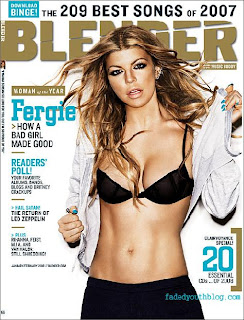Denotation:
The magazine consists of a colour photograph of a woman looking directly at the camera. It is a medium long shot showing her head, arms and waist. She is standing up in a posture and chest and belly is visible in the shot. The background of the photograph is white, and the photograph covers the whole of the magazine cover. Behind the woman is the BLENDER masthead, and in front of her are five separate cover-lines in blue and black. The photographed woman’s name is in blue and there are dashes between each cover-line separating them. There is no bar code visible in the front cover.
Masthead:
BLENDER’S masthead is very distinctive: gold writing in capital letters and a slice of line going across from the right to the left. The font used is a sans serif font, and all the letters are all in upper case letters. The font used is famously used for simple meanings but the slice of line going across connotes that BLENDER magazine can be filled with dangerous excitements. The word ‘BLENDER’ comes from a domestic machine found in the kitchen of our homes to shred ingredients together, suggesting that this magazine has a collection of different types of music and compresses them into one magazine. All of the musicians who have used this word in their lyrics have a reputation of having their own style as well as taking up other styles to make them who they are.
Character:
The cover photograph is of the successful American singer-songwriter , actress and fashion designer ‘Stacy Ann Ferguson’ better known as ‘Fergie’.
Composition:
She is posed in a very sexy kind of way. Her cloth, body language, and clothing, are very sexually suggestive and provocative.
Costume:
Her clothing is a grey jumper with a zip, a bra, and black trousers or shorts(not fully visible). This costume has been chosen carefully to appeal to the target audience of the magazine, who are most likely to be male. The clothing worn is similar to the costume she had used in a video shoot she did with her band ‘The Black Eyed Peas’, which was formed in Los Angeles in 1995. The zip of the jumper exposing her chest and stomach and bra completes the look.
Nvc:
Her non verbal communication is also very seductive. Her hair if blowing backwards with the fan in the studio that’s not visible in the magazine and her hands placed on her jacket that’s been opened apart opened apart, as well as her mouth opening her white teeth and she is looking directly at the camera.
Lighting:
The lighting is high key, as the photograph is meant to display daytime.
Setting:
There is a little setting, however the white background connotes the photographer being a good girl and is linked with the cover line ‘Fergie: HOW A BAD GIRL MADE GOOD’.
Cover-lines:
The main cover-line that relate to her says ‘Fergie: HOW A BAD GIRL MADE GOOD’. This is making a reference to a piece of music she did before this picture was taken, that was called ‘London Bridge’. This music and video to accompany it was controversial because it featured her and her dancers wearing revealing clothing and suggestive dancing. This was the video where she made the world know what she’s like as a lady and her image become more adult and sexy. ‘HOW A BAD GIRL MAD GOOD’ reference relates to the fact that Fergie had settle down with a partner and now planning on a family. The different cover lines tells us that this magazine doesn’t concentrate on just one genre of music, and doesn’t only focus on one music either, but is diverse in what it chooses to write about. Artists mentioned on the cover lines include Britney spears, Rihanna, Feist, MIA, Led Zeppelin and Van Halen (there is a definite emphasis on American artists). The way the cover-lines are written reveals that this magazine also focuses on current news events ‘20 essential CDs… of 2008’. All of the cover-lines use a sans serif font, connoting modern tradition. It suggests ‘BLENDER’ magazine is very modern even though it has been of existence over a long period of time. This can tell readers they receive accurate and entertaining journalism.
Target audience:
Considering all of these points, the likely target audience would be people (male and female, though more male audience member than female) aged 21-50. They would have a good knowledge of popular culture and a possibility of interest in a wide range of musical styles and the music industry generally. They are likely to be well educated/well read, and have an interest in American popular music.

No comments:
Post a Comment